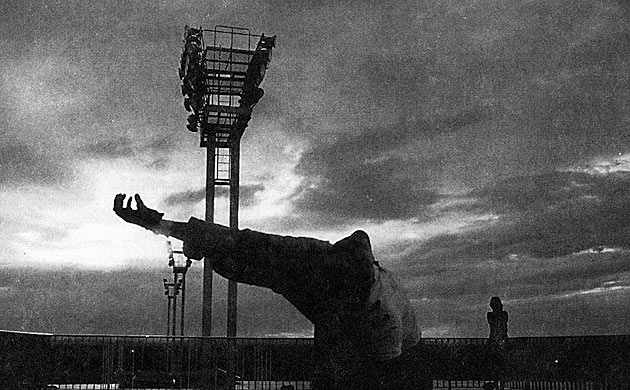La Jetee (Chris Marker, 1962): France
Reviewed by Byron Potau. Viewed on DVD.

Who says science fiction needs great special effects? One of the most brilliant science fiction films, Chris Marker’s minimalist La Jetee, uses only still black and white photographs, except for a three second segment, and a narration to tell its story, but it is completely unforgettable and far superior to the 1995 Terry Gilliam film, Twelve Monkeys, which it inspired.
The film tells the story of a man (Davos Hanich) who is haunted by an image from his childhood of a woman’s face that he saw right before he witnessed a man die when he was at the observation deck at the airport. When World War III destroys Paris and much of the rest of the world making it uninhabitable with radioactivity the survivors live underground where one group of men have taken several other men prisoner. Our subject is one of the prisoners and he is next to be experimented on by the group’s scientists who have singled him out because of his fixation on the image from his childhood. Knowing that civilization is doomed their only hope is to find a way to get help from the future and so have been conducting time travel experiments on prisoners with strong singular memories, many of whom have gone mad from the shock of the procedure. After several experiments they are able to send our subject back in time where he meets the woman (Helene Chatelain) whose face has haunted him.
Because the film has an apparent handicap in relying on still photographs it would seem surprising how well the film succeeds, but in fact it feels amazingly natural and we hardly miss motion at all. The use of the still photographs is a tremendous compliment to and in perfect tune with the film’s theme of memory.
The photographs, themselves, are brilliant and memorable compositions with some of the most starkly poetic images ever put on film. However, it is not just the aesthetics of the images, but how they are photographed and edited together which moves the film forward so smoothly. There is panning and zooming on the individual photographs, and Jean Ravel’s editing does not just show one photograph after another, but cuts them together like a scene to create tension, mood, and a sense interaction between the characters.
The film’s brilliance is also due, in no small part, to Marker’s gripping and intelligent story. The film’s twist ending is particularly satisfying. The narration by Jean Negroni has a grim sparseness to it which matches well to the film’s post apocalyptic surroundings.
The sound design by Antoine Bonfanti helps to underscore the scene and bridge the gap between the photographs as we connect them into a fully realized scene.
Indeed, all of the components of the film; story, narration, editing, sound, and image seem to be in perfect unison creating not only one of cinema’s greatest science fiction films of all time, but one of the great works of art of the 20th century.
About this entry
You’re currently reading “La Jetee (Chris Marker, 1962): France,” an entry on Student Film Reviews
- Published:
- 04.13.10 / 5pm
- Category:
- DVD, Films, Short films
No comments
Jump to comment form | comments rss [?] | trackback uri [?]